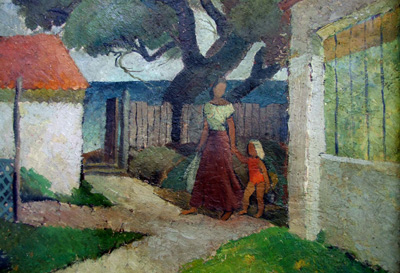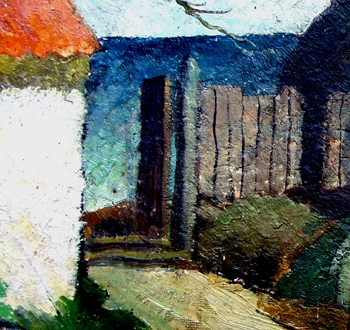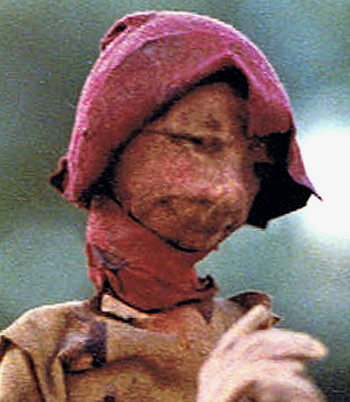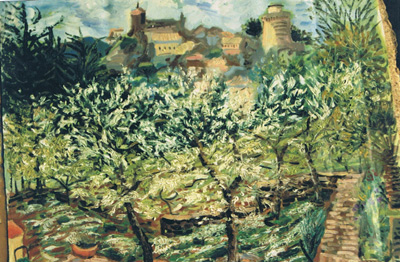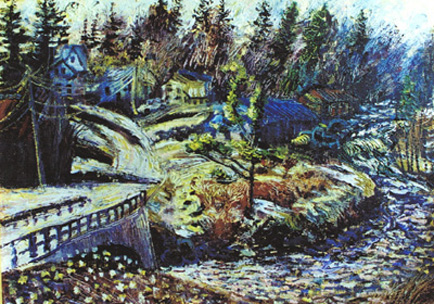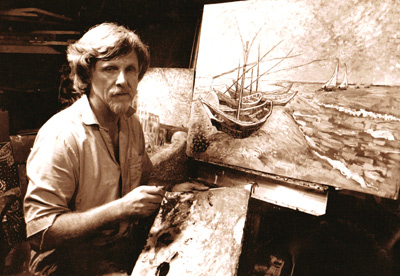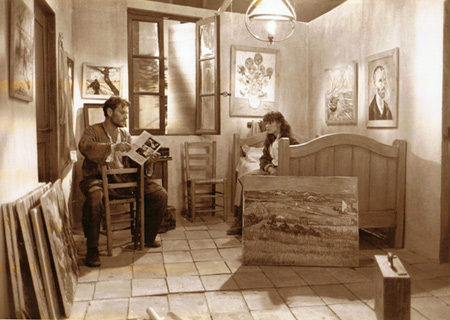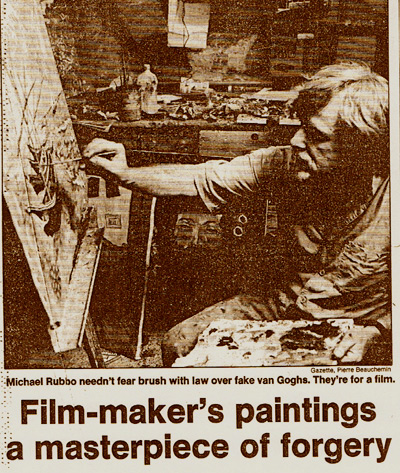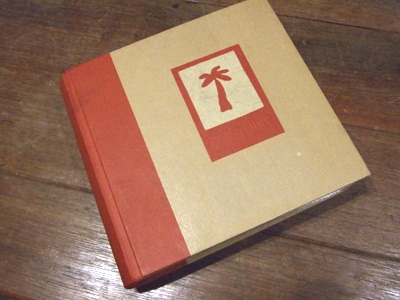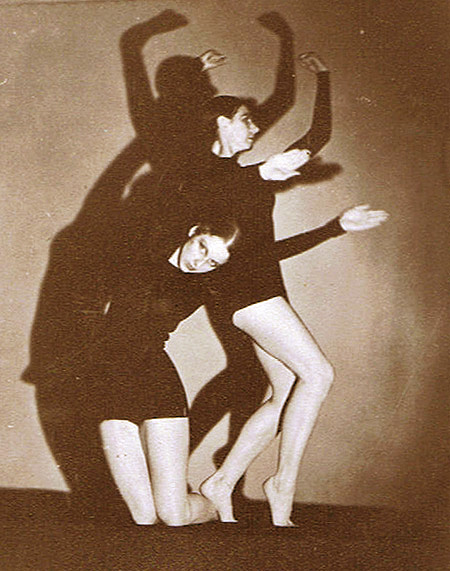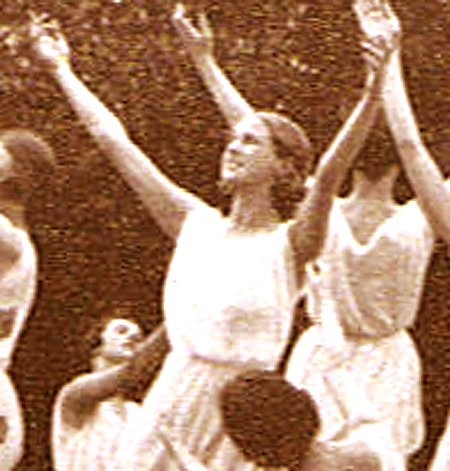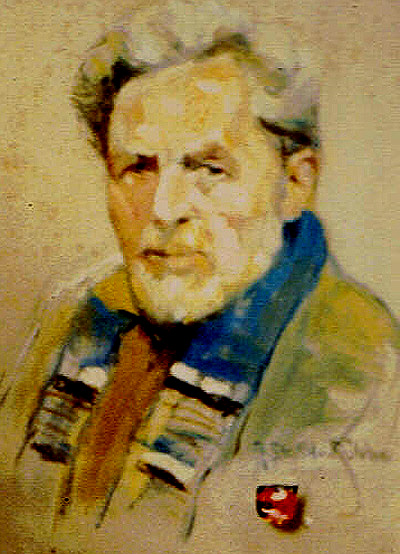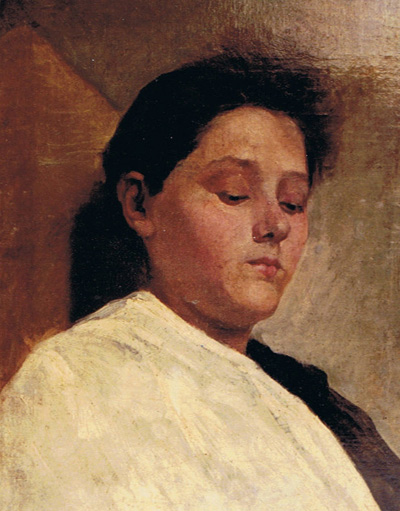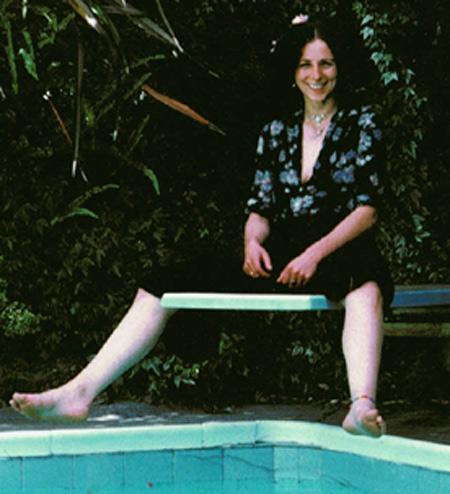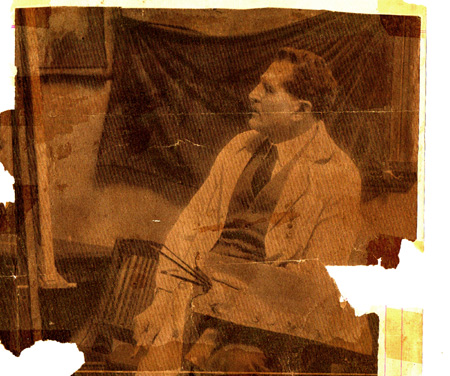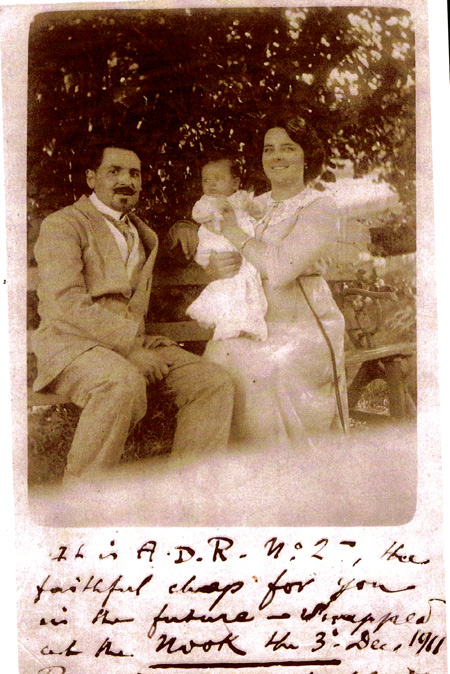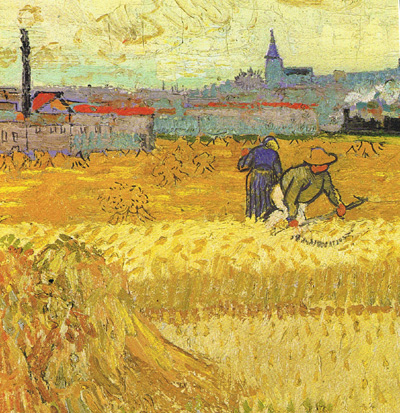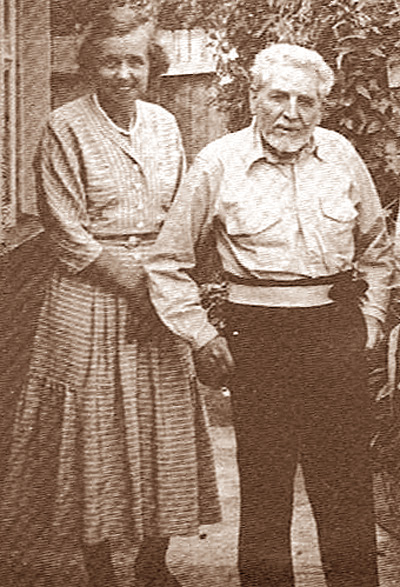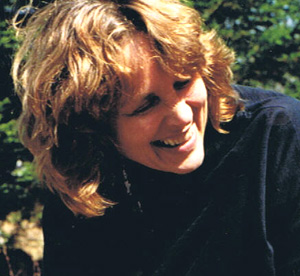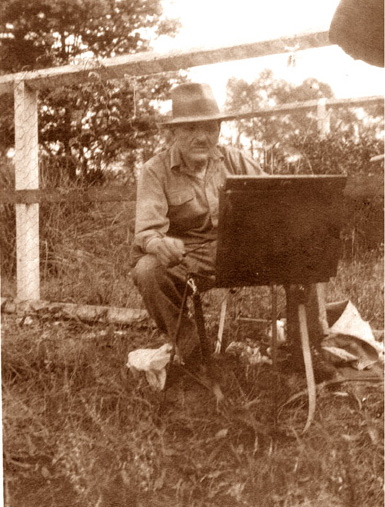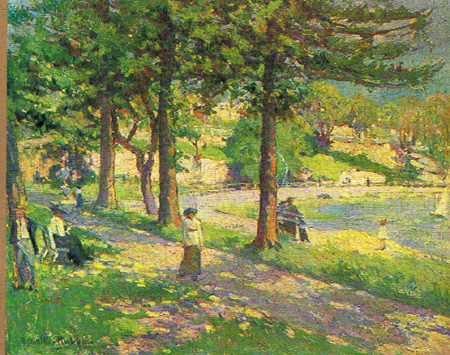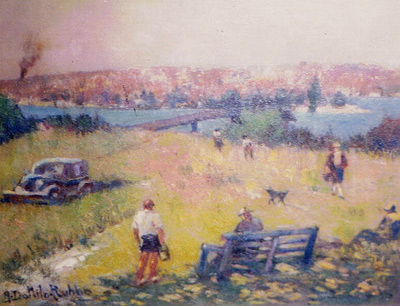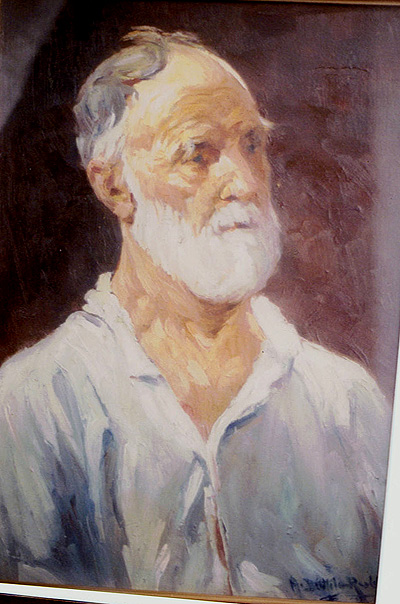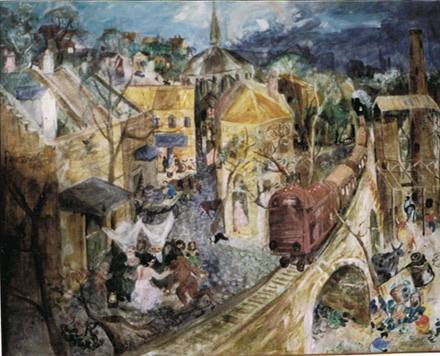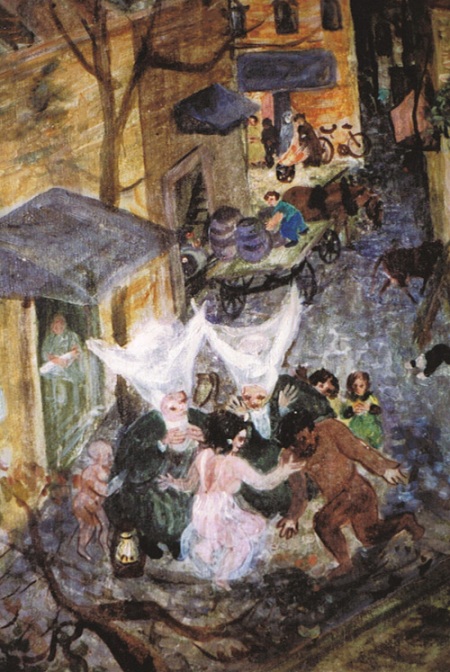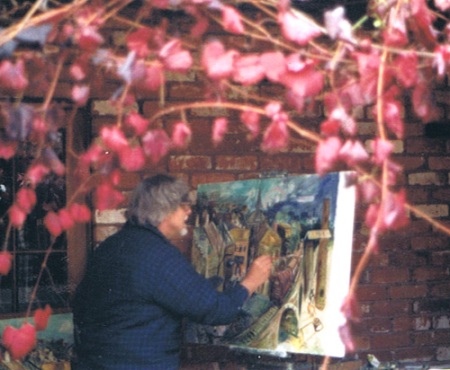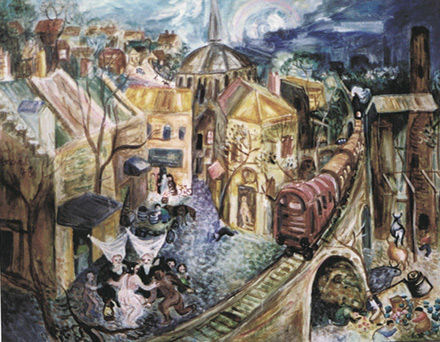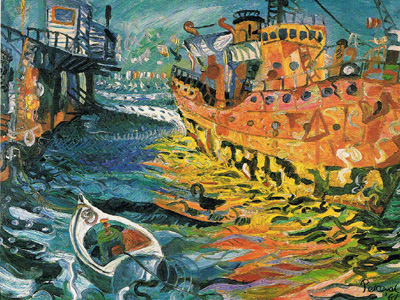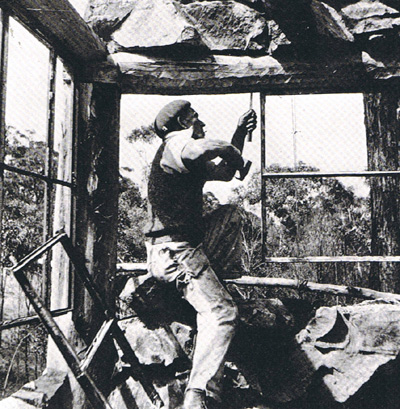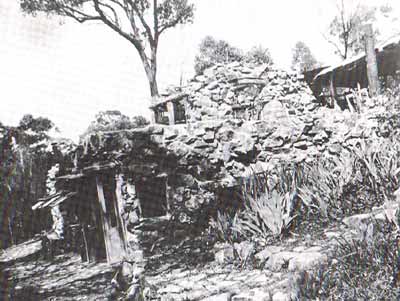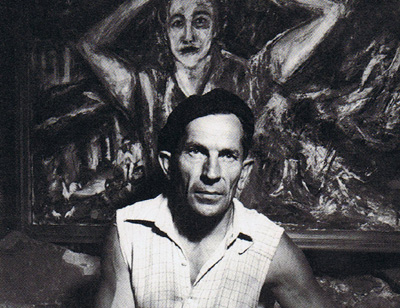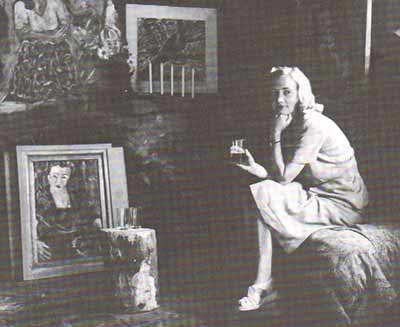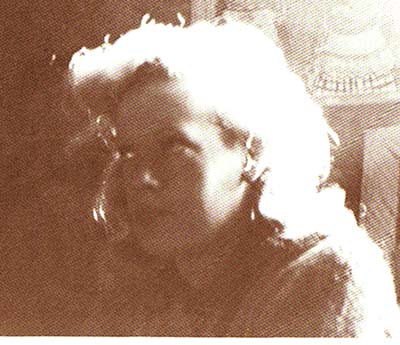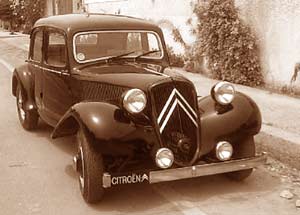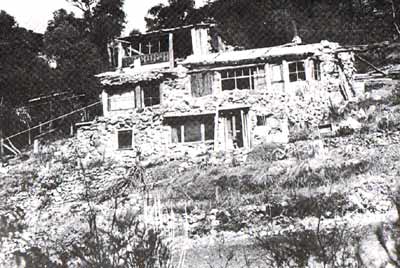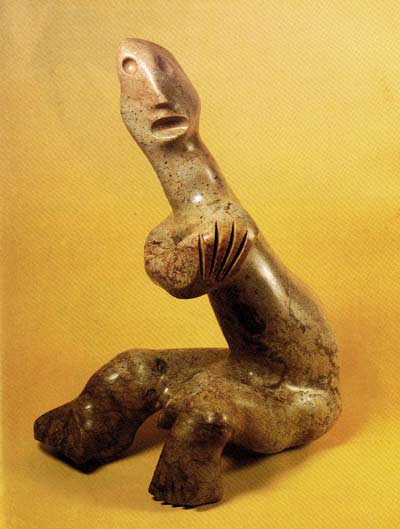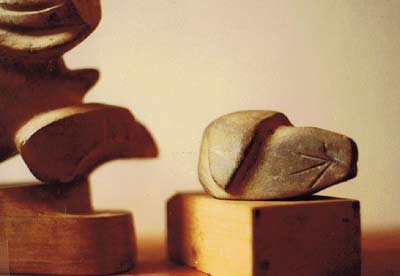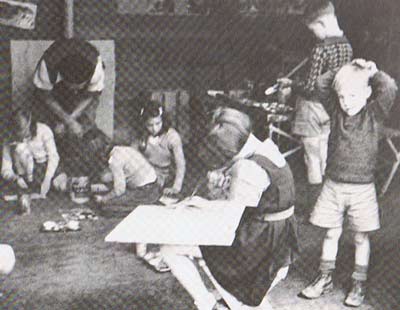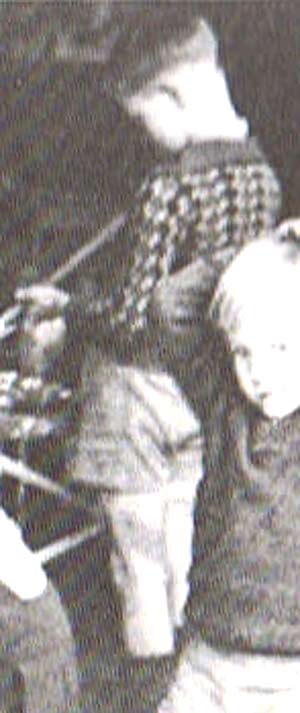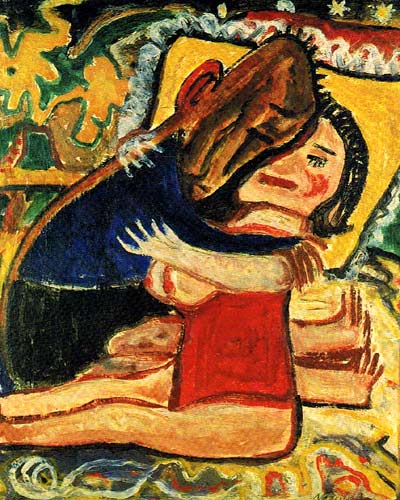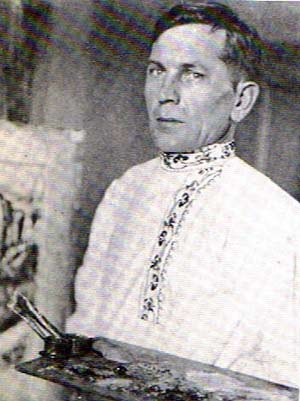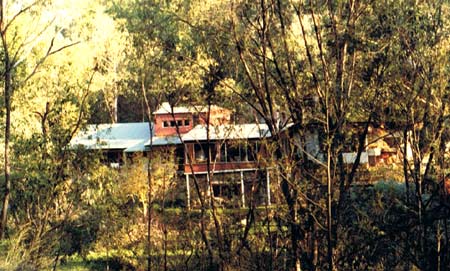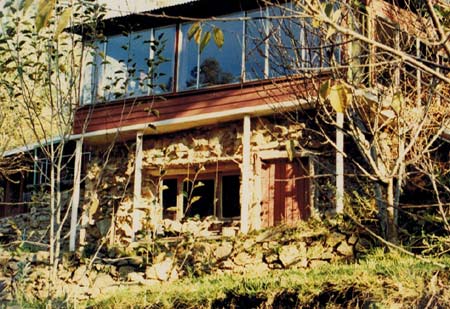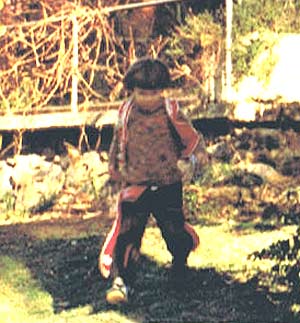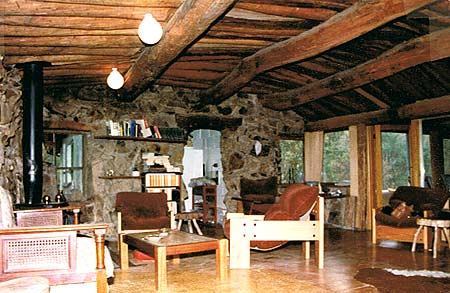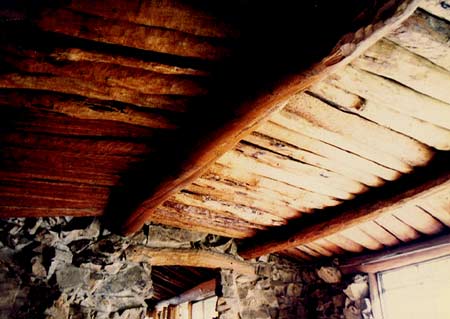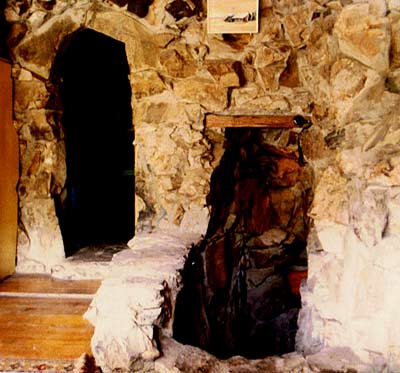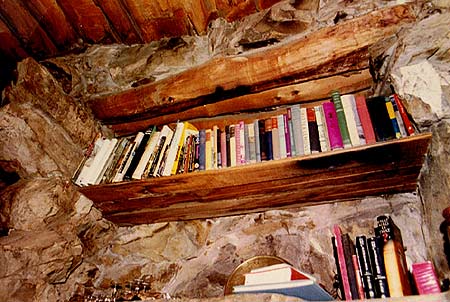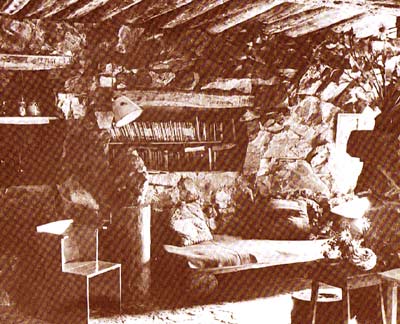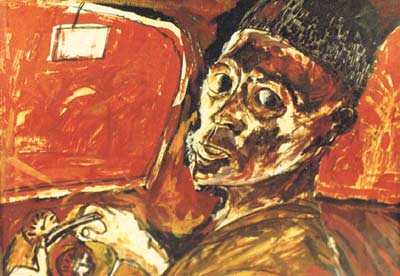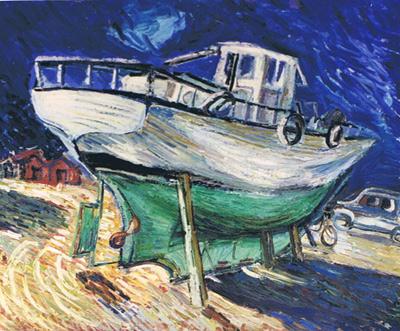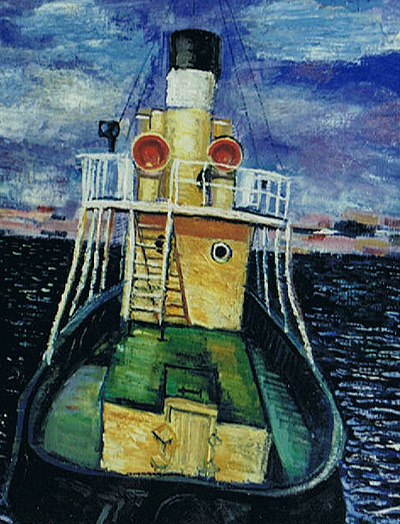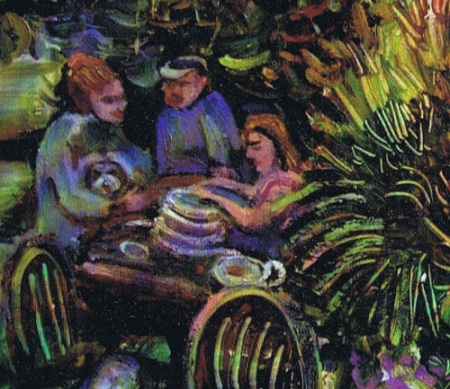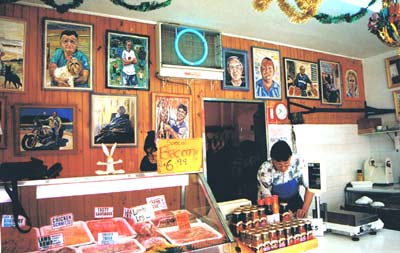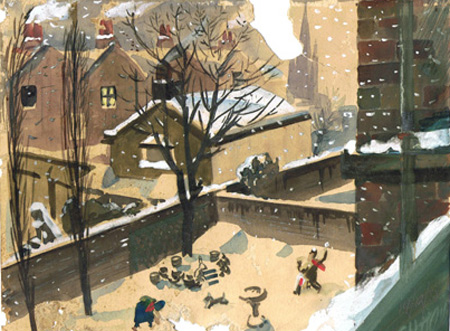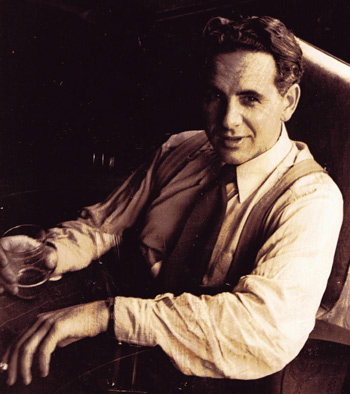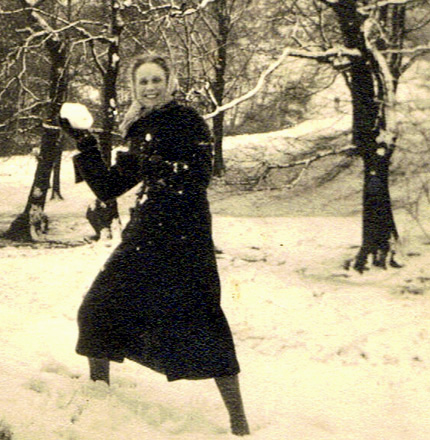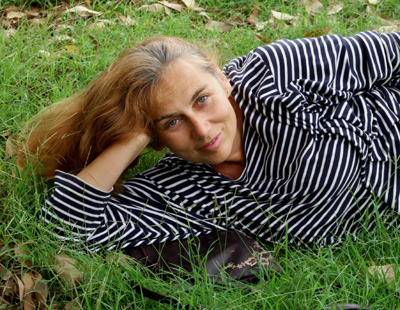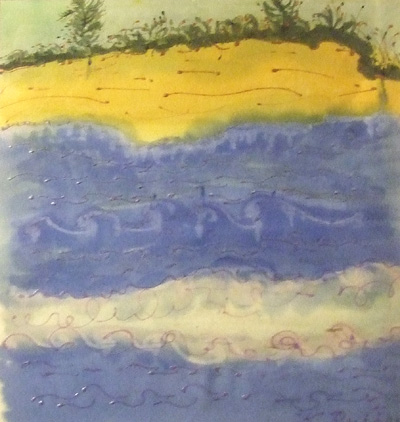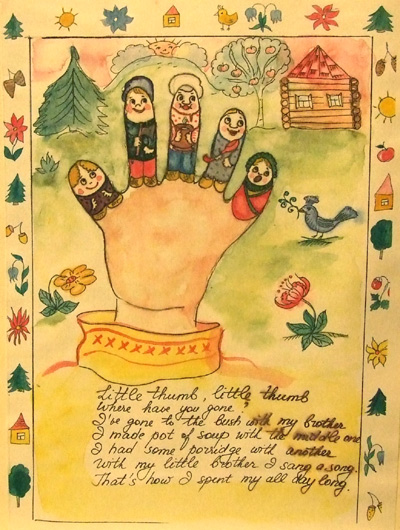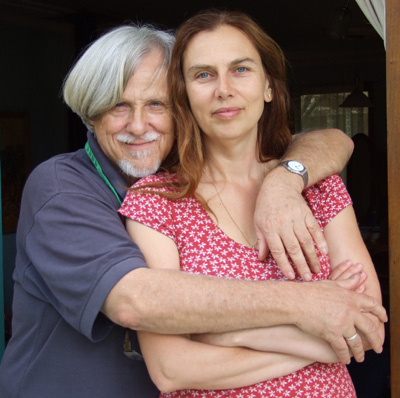This masthead is a picture my mother painted in the early 1950’s. It was done at Boat Barbour (Now called Bateau Bay) just north of Sydney, where we went for those fantastic holiday holidays just after the war.
Mum has painted her sister, Joan, leading little Anna by the hand (she’s my sister) as they approach the gate to the beach.
Here’s Mum’s picture full size.
…………………………..
Ellen Rubbo. Bateau bay.
Here’s My Uncle, Francis Sutton, also at Boat Harbour round about the same time. Francis has the painting now. He was married to Joan. She left it to him when she died. I’m glad he has it.
2. A theory about how and why.
3. Stories from van Gogh.
5. Antonio Dattilo Rubbo, the teacher and bohemian.
6. Kiffie Rubbo, the curator
7. Francis Ellis, devoted protege
8 James Wigley
9. John Percival
10 Danila Vassilief.
11. Ellen Rubbo.
12. Francis Sutton.
13. Norman Lloyd.
14. Katerina Korolkevich Rubbo
15. Mike Rubbo
4.This is an experiment. I’ve teamed up with the Manly Art Gallery to encourage people, you perhaps, to create an art blog or an art scrapbook, a record of the art in your life.
We call it, Family Art Stories, FAS for short. There’s a reason why I feel this is a very good thing to do. But more of that later.
First, to see how a FAS blog actually feels, I’m trying it myself, here.
Mum’s painting and Boat Harbour itself are good places to start.
Our best family holidays were there. If we were lucky, we youngsters were allowed to ride the flying fox down the cliff to the camp, a cozy cluster of huts, huddled against the sea like a kid crouching behind a dune.
The camp was right on the beach with just a sheltering fence and a great shade tree in between it and the bay.
June Gordon was at least ten years older than me when this photo was taken.
Still, I think I had romantic thoughts about her. Some distant bell of memory, rings.
And why not, so sweet she is. Ah, old fashioned girls in old fashioned cozzies!
I do remember clearly going through that gate, dashing down the burning sand, and plunging into the warm turquoise water.
I remember the small fat man always sitting just outside the gate.
That was Percy Usher, round and brown as a berry, happy under the shade tree, dreaming the days away beside a tub shaped dingy, ready to rescue us if necessary.
Percy had come around Cape Horn on the Windjammers. He’d fallen from the mast one trip, they said, and got a great cut on his head. Sometimes he’d show us the scar.
Beyond the shade, in the sun’s glare, another Uncle, Pink, stands forever youthful.
His real name was Frank Gray, Pink being a nickname from childhood. He was was a great surgeon, Frank.
He died recently in his nineties. Ah, how fast life passes. How quickly things and people become ever so long ago.
Evelyn, his widow, is very kind. She’ll contribute greatly to the blog because she’s giving me three paintings by my mother that she has. That’ll be a thrill.
Pink was Mum’s brother.
We all know the power of photos to work like this, to tug at the heart through memory. But what about paintings?
Sadly, many Australians don’t go for paintings, not enthusiastically. They spend lot’s of money on cars , clothes, houses, and yet rarely anything on pictures. “What’s the point?” they’ve said to me.
When I was working for ABC TV as an executive producer, we made a documentary series on dysfunctional families. As I watched the rushes on these people, the screaming out-of-control kids, the desperate parents, I noticed that there was no art on the walls of those houses. Bare walls!
There was nothing to rest the eye, like here. Nothing to let you out of the tension.
Mike Rubbo. Sprinklers and rape seed in Finland.
I asked social workers if this was typical of such families. It was, they said. Did they think art on the walls of such families would make any difference, have a calming effect? They had no idea. No one had ever done a study of that, they said.
Recently, I began asking my older friends if they remembered what was on their walls as children.
I was astonished to find that many friends had the most vivid memories of some picture or other. A calming landscape, or something religious and scary, a portrait with a strange look perhaps, all were remembered. The paintings were not necessarily talked about, thought about, they said. They were just there always there, and being there, were somehow comforting.
Of course objects too can work the same way. Francis Sutton, that dear uncle of mine, had a little figure perched on his mantlepiece. Made of suede, it had come from London long ago, Baker st. he says. The little flute player is lost now but not forgotten.
My theory is that art in a home does make a difference besides being decorative and showing you have taste. It provides a quiet continuity and something else very often, lingering mystery. That’s why it’s remembered .
Paintings may be the same size as a TV screen, But they never change. A painting has no plot, no commercial breaks, and yet there is a story, clearly a story or one you make up.
Mike Rubbo. My Grandfather’s village, southern Italy., Pontelandolfo
I go further and suggest that, as today’s kids get bombarded with more and more audio visual material , ever quicker images, it’s possible that paintings which never move, never change, might be even more important than they once were.
Film makers in the cutting room hold shots for far less time on the screen than they did before. I know I’m one of them.A second or two tells the story these days.
Maybe it’s good, by contrast, to have an image which won’t change in 50 or 100 years, as a sort of balance.
I left this picture in Morin Heights, Quebec, where we used to cross country ski. It first hung in the general store, Beauty’s, and is now in the library, I’m told. It can be there forever, recalling we who once lived there.

Mike Rubbo. Beauty’s general store. Morin heights, Quebec.
But how to persuade people to test the power of slow images when they’re in the fast lane, and hanging paintings is just not something they do?
The story aspect helps. We are all addicted to stories, are we not? If I stress the fact that story is a large part of art, this may be a way into art for some people who other wise don’t get it..
The painter’s story. The picture’s story. Where’s that village? Where does the road go? I know. I painted this scene. I could tell you
Mike Rubbo. Spring, Laurentians.
I’ve always been drawn to the story aspect of art. Maybe that’s because I’m part painter, part film maker.
I once made a film for kids about van Gogh called, Vincent and Me. It was created with the help of my Producer and Friend, Rock Demers, head of La Fete in Montreal.
Rock had the vision to see that you could make films for young people which did not stick to the usual plots. His series was called Tales for All.
While I put many of Vincent’s most wonderful paintings up on the screen in that movie, I went to some trouble to tell his story too. I knew his touching story added to his art and the fascination he arouses.
Here’s the actor playing Vincent with one of the most famous van Gogh paintings, the blue cart .
Copies like this blue cart which I needed for the film, ( the was no chance to use the originals of course) were painted in a dingy Montreal basement over many months, long before production began.
Here I am in Dorothy’s basement, working on Vincent’s fishing boats. It’s 3 am.
I was in a rush. I had to fill the room in the Yellow House where van Gogh lived his summer in Arles.
My copying, a perfectly legal thing to do, (Vincent himself copied copiously) became a story in itself when the film was released
I found it was also a good story to tell the kids, those who auditioned for the main parts. I told how them how I’d copied the paintings all alone, late at night, and how spooky that was.
I told them I’d had the feeling that Vincent was at my shoulder and that if he didn’t want me to make the film, he’d make sure the copies were bad.
I wonder if I ever told this to Rock? He may not have been amused by my superstition , especially since he had several million dollars riding on Vincent and Me.
You know what? I believed this myself, at least partly. Here’s one of the copies.
Green Corn, after Vincent van Gogh. Mike Rubbo
If you click here, you can see a clip from this film
In a way, I don’t help my case by telling this story because it gives the impression that what we propose, This Family Art Stories idea, is mostly for people who make art, as I do.
Not true at all. We are hoping, the Manly Art gallery and I, that this will appeal to people who may have little art in their lives right now, and for whom collecting pictures or sculptures would represent a very new path.
Tell people the story and often you show them the way to the painting or the articfact, reinforcing their reaction to the image. Get them digging out stories and you give them art which has a special meaning for them
When I do a picture, usually painted pleine aire, I write all the details about the day and place on the back.
If I’m painting it for somebody, I photograph the new owners with their picture, like this couple.
I just liked their classic fibro beach cottage which is near where I live. I painted it and gave them the painting. You can see they were quite surprised. I’m sure the story’s still told.
The fibro on Avoca drive. Mike rubbo
We originally conceived Family Art Stories, FAS for short, as based on a coffee table scrap book which everyone in the family would help create.
Inside this handsome book blank paged book would go photos of paintings now owned, notes on the artists one has been able to find, stories of how and where the pictures was given or bought.
The couple, above, if they had such a book would have included my photo of course and maybe some notes about why I like fibro beach houses, and how sad I am that they’re all being pulled down.
This scrap book would be very much about provenance, a very important concept in the art world, meaning where something comes from in every sense of the word.
Now, I’m thinking that, since it’s so easy to start a blog such as this, (they say you can do it in five minutes, and it’s free) that maybe FAS blogs are probably an exciting alternative to the coffee table book.
If that’s so and the idea takes off , each art blog could be called:www. family art stories/ name of family.com
This would mean that this blog collection could become a searchable archive of art and family life, one which might grow to be a true testing of the theory that art adds a lot to families.
If you like challenges, take some photos, grab some memorabilia, and put it all together on a wordpress blog like this one.
WordPress boasts blogging is easy peazy, and you should be blogging half an hour after you’ve googled the name, wordpress. If you do take the challenge, let me know how it goes.
Back to my experiment with this FAS blog.
There is so much to tell about what was on our own walls in Melbourne when growing up.
My Mum was shy about her work and never paintings her works on our walls that I remember, though there may have been these framed photos of her as doing modern experimental dance.
Is that really my Mum on her knees?
Ellen Rubbo in the middle.
There was another artist in the family as well as Mum and he got hung. This was my Grandfather, Antonio Dattilo Rubbo .
Antonio Dattilo-Rubbo was a colorful Italian, later made a Caviliere, which is a sort of Count. Rubbo emigrated from Southern Italy, the Naples region, in the 1890’s to set himself up as a teacher and painter in Sydney.
He became quite famous not so much as a painter, though he painted a great deal, especially portraits, but as a teacher. Many of our Australian greats, painters like Grace Cossington Smith, Roland Wakelyn, Roy DeMaistre , Donald Friend, and Lloyd Rees, all were his pupils.
Here’s Grandfather’s self portrait. It does double duty for this page because it’s also a painting which hung on our walls when I was young, and is one of my earliest memories of art that meant something to me.
Self portrait. Antonio Dattlilo Rubbo.
Even as a kid I picked up on the free, sketchy, quality of this portrait, thinking that was bold of him.
Unlike my brother, Mark, I liked it better than another portrait of Nonno’s (That’s Italian for Grandfather) we owned, an accomplished head of a pensive woman which was a somehow a bit stiff for me.
Here’s the young woman my eyes passed over in favor of Nonno’s self portrait. Yet when I see her now, I realize that some of my deep down ideas about people keeping their own counsel, about being private, may come from this painting. It had more impact than I imagined!
Unknown woman. Antonio Dattilo Rubbo
Mark Rubbo, the bookseller. He thinks my memory is faulty.
He’s sure that our Sister, Kiffie Rubbo, found this painting of the pensive woman long after I’d left home.
Kiffie died tragically young but not before she’d become a major force in the Australian art world. Daring, playful, and profound, she excited everyone.
Her story will be told in another post.
I used to look at Nonno’s self portrait often, thinking about him emigrating out here when there were no foreigners in Australia to speak of. It seemed very brave of him. He sang opera and fought duels too.
I liked also the explanation he gave me of how he chose Australia. He told me that a ship load of beautiful women, strapping Amazons, had stopped in Naples on it’s way from Australia to Europe. He and his friends had never seen such creatures before, such assurance, such glowing good health, and they decided then and there that Australia was calling them.
Another version has him running from a marriage promise. I think maybe he was actually imported by a rich family as a tutor. He did end up with the Mort family (very wealthy folks) as tutor to their daughter, Eirene Mort, on his very first night ashore. How was that possible if not arranged ahead of time, especially since he spoke no English?
Soon, Rubbo seems to have captured Sydney. He has an apartment downtown at a time no one actually lived in the city. He’s on all the important committees. He’s advising the Government on art education, and is even writing letters to the paper on city trams, newfangled transportation which he finds too drab, and which he advises be daubed in the colors of the Mediterranean.
He ‘s constantly in the press too, photos as well as comment. This is a treasure, a scrap of newspaper, falling apart , which came to me some how.
He loved painting his two boys. My Father, Syd who became a famous scientist and the younger, Mark, who died of Menengitis at 15. This tragedy devastated Nonno and came to kill his wife, Mildred.
I think Syd is probably the robust scout and Mark the wistful figure in the foreground of the second painting.
The Scout, Antonio Dattilo Rubbo
Antonio Dattilo Rubbo. Title unknown.
Three years ago, I was visiting the Northern Beaches artist, Pamela Thalben Ball. I knew her mother had been a student of my Grandfather’s. I hoped for some stories.
Pamela feared she had nothing much to give me, and was worried I’d come so far on a wild goose chase. For, apart from a small dark Rubbo canvas, she had nothing to show or tell.
But then, as she opened a cupboard, out fell a postcard dated, 1911. She claimed she’d never seen it before, and had no idea why it was in the drawer.
It was addressed to her mother, the prize student and was from her teacher, Antonio Dattilo-Rubbo, showing off his wife, Mildred, and new son, my father.
In 2007, Pamela had a show at the Manly Art gallery. I was asked to open it. I told this story of the postcard and, without having thought it through before , launched into some remarks about the power of the stories in art , stories like this postcard apparition.
My audience was intrigued. That night the Family Art Stories idea was born.
Nonno died when I was twelve. I never saw him paint that I can remember
These two landscapes of his are another mystery. I don’t remember them from childhood. Indeed, I don’t know where they are, or even where I photographed them . A mystery to be solved by the blog.
If they had been on our walls, I would have wondered where they were painted. What’s that pile in the foreground of the first picture ? Wood chips? And yet there are no trees in sight. And the second, is that Sydney harbor behind the shack?
As a kid, I would not have known what I now know, that Dattilo Rubbo was probably the first to bring color prints of van Gogh to Australia, that he praised Vincent to his students and called Grace Cossington Smith, Mrs. van Gogh.
I see now a connection between this painting and some of van Gogh’s works from Arles, those painted late in that memorable summer spent with Gaugin
Antonio Dattilo Rubbo. Title unknown
The touch is different to be sure, But one can see how van Gogh (below) was freeing up my Nonno’s hand
Detail of painting by Vincent van Gogh
This picture (below) too, I know nothing about, and have no idea where this painting of his might be now.

Antonio Dattilo Rubbo. Title unknown.
Nonno painted his devoted protege, Frances Ellis. He’s painted her to look curious, a bit wary.
Will she take eventually over of his famous art school on Pitt st. or not? Was that the question?
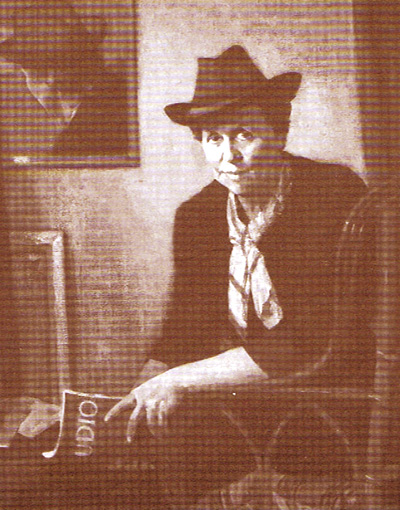
Francis Ellis by Antonio Dattilo Rubbo
She painted him at peace, free to dream. Her portrait was exhibited at the Mostre D’Outtremare, Naples 1942.
This must have pleased them both, especially Nonno since it was in Naples that he’d studied art, 60 years before.
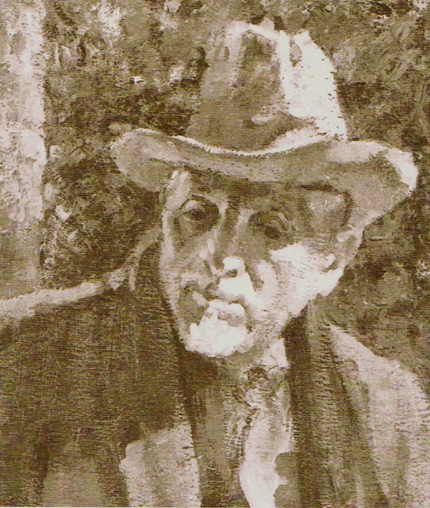
Francis Ellis. portrait of Antonio Dattilo Rubbo
Francis Ellis and Antonio Dattilo Rubbo
What happened to Francis Ellis, his loyal companion of late years and the keeper of the School? We know she went back to her native New Zealand when Nonno died in 1955.
She herself was gone in 1971, In the years between did she paint?
In the early nineties, a Sydney gallery held a show of recently discovered Dattilo Rubbo paintings. Nice as they were, they were not his according my sister Dr. Anna Rubbo, much to the fury of the gallery owner. Those who knew his work tended to agree.
My Sister the Architect, Anna Rubbo
Nonno loved to paint outside, pleine aire, as did van Gogh. He did so till quite old.
There is a figure of a man in the foreground of Roland Wakelyn’s famous painting, Down to Berry’s Bay. The man sits on the slope, painting, a folding easel in front of him. I’m convinced it’s our Nonno.
My grandfather helped found the Manly Art gallery which, as I mentioned, is behind this Family Art Stories initiative.
He lived in Manly in the early part of the 20th century and here painted the Corso, as it’s called, the curving parth which leads round to where the Gallery now stands.
The Corso, Manly. Antonio Dattilo Rubbo
There’s something I need to do for Nonno.
In Pontelandolfo, the small town he came from inland from Naples, lived Elda Rubbo, a distant relative. Nonno was in touch with her in the 40’s and sent her some paintings as well as many letters..
Elda died last year, 2007, and now I need to bring his pictures home. One is Sydney harbour, it might be a picnic. It’s been on Elda’s a wall in Italy for 60 years.
Antonio Dattilo Rubbo. Sydney scene.
The other is the portrait of an unknown man. Maybe we’ll find out who he is if we get him home.
Antonio Dattilo Rubbo. Title unknown
This retrieval may help me with some guilt I fell about Nonno. I’ve been a documentary film maker for 40 years. I could have made a film about him while his illustrious students were still alive and and were ready to speak so fondly of him.
I thought of it . I came close but put it off. Now, I think it’s too late. They’ve almost all gone, all except two I know of, Tony La Spina and the Sculptor, Tom Bass.
My second twinge comes from the fact it was not Nonno’s paintings which most fascinated me as a child. It was the two pictures which follow.
The first I know little about except that it was painted by James Wigley. The family art story blog will try to find out more. My brother, Mark, has sent me the website of James son, Julian. I’m going to find out more.
James Wigley. Title unknown
I loved the strangeness of this image. When very young, I was fascinated by the distortion of the massive legs on this seated man. Were they swollen? Had something bitten him? Later, I took on the idea that if I was to paint myself, strict realism was not everything, that these curved banana-like legs were superb.
This picture still haunts me and has always done so. Who was was he? What was his relationship with the Aborigines who drape themselves around the truck?
As I got older, I discovered a certain white arrogance in the image, the way the black people look to the painter questioningly, while the man on the truck feels no need to do so.
This 1948 Percival we had was my favorite image. For a time, John Percival, living not far from us at Eltham, liked to do Breughal -like paintings. Here he puts exotic Nuns with white head dresses in a Fitzroy street. I was fascinated.
John Percival. Nuns in Fitzroy ?
Our suburban lives seemed so tame. How often I thought of of going down into that street and dancing wildy too. More often I rode that suburban train out of the scene, catching just a glimpse of something weird going on below that I’d always miss. .
Why had the truck overturned, I also wondered? Was it because of the loose cow?
John Percival. Nuns in Fitzroy (detail)
As a family, we decided, sadly, to sell this picture. Agreeing, I none the less felt we could not bear to live without some record of this, our most special image. Do my brother and sister, Anna and Mark feel the same way? I don’t know.
I decided to make a copy as I’d done with van Gogh, being careful leave out Percival’s signature and to build in small differences as well.
Here I am hard at work at my brother Mark’s former house, keeping some Percival in the family. Mark does not paint. He’s Readings, the famous Melbourne bookseller.
And here’s my copy. No great, but not bad either.
Mike Rubbo. After John Percival’s Nuns in Fitzroy.
As I said, the original street with Nuns was painted in 1948. I was ten at the time and so this picture can’t be a memory from early childhood, but the Percival is the painting I remember best, and on which I dreamed the most.
I met John Percival, years before I did the copy . He was about 15 years older than me. He still looked like a naughty boy
John Percival self portrait 1947
Above all, I loved his boats at Wiliamstown.
John Percival. Yellow painted ship 1967.
There were painting everywhere in my childhood and there were encounters with artists who were friends of my parents. The most fascinating of these for a small boy was Danila Vassilief.
He was a white Russian who had fled the Bolshevik takeover of his country, come to Australia via the Carribean and, at the time we knew him, was building himself a stone house at Warrandyte, 30 miles from Melbourne.
It was rough hewn place built with rock blasted from the hillside, blending in like an animal lair.
It went up and up, level on level as Danila felt the urge.
He was iresistable to women with his strong face and his gentle voice.
When not painting sculpting or blasting, I think he was making love, though as a small boy I did not know what that was.
I listened to Saturday night radio dramas while they played noisily
I was there for the weekend sometimes, me Danila and his girl friends.. He was teaching me, that was the idea.
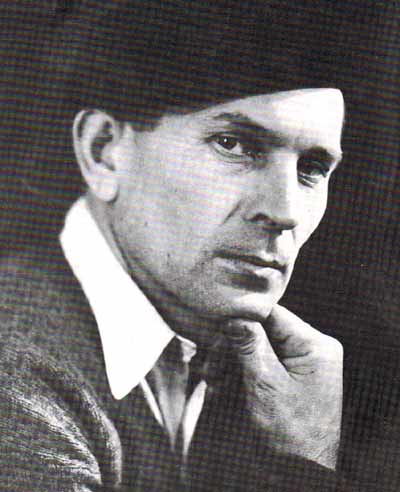
I remember he’d pick me up Friday nights from a bus at the Warrandyte shops and drive at breakneck speed through the night on the bush tracks to the house , headlights slicing the dark, dazzled rabbits hopping aside.
The car was a Citroen, a French police model. Like everything else with Danila it was strange , exciting…
But too posh for the house. It had a gearshift which Danila furiously pushed and pulled out of the dashboard, like he was punching the car. Sometimes I was allowed to work it. The house was pitch dark as we came up to it.
As we swung into Stonygrad’s home track, it later came to be called that when he married the communist, Betty, I’d glimpse something else any boy would find irresistable.
He had an old tram which sat on the land as a place to camp while he built his house of stone. It was not like this exactly, much more dilapidated, cupped in growth, but this gives the idea.
Stonygrad went up and up, floor by floor. I got the idea that he’d fill a floor with paintings, then, out of space, he would go up one more to get them out of sight, since none sold.The
The second floor then would fill and up he’ d go again. By the time I knew him, he was mostly into sculpture and was working on the roof, an undulating cement slab, stacked with stone and grinders.
Here, he sculpted his favorite stone, Lilydale marble, carving its curves with those screaming grinders. He made strange shapes like beautiful deformities, so soft to stroke, you’d never guess how hard they’d been worked
Danila Vassilief Yankee Caesar 1951
Meanwhile I, a timid kid, made a dog’s head as realistically and undeformed as I could.
Mike Rubbo Dog’s head. 1948
I’m not surprised to find myself in a small group class, looking very neat and proper.
And alone. Me at the back.
Truth be told, I was a bit worried about Danila. I might have come to him because my parents put me in an experimental school on the opposite hill, Koonong. Classes were held outside on logs and I had to bathe naked with girls, which I hated.
I was both repelled and fascinated by his art. If it did hang on our walls at home, I’ve shut it out of my mind.
Danila Vassilief. Woman driving posh car. 1955,
They were as strong and wild as he was,
Danila Vassilief. Alec and Joan 1944
I guess this is the fatal flaw in my thesis about calming art. And yet, I would say that I came to like Danila’s work through his story in the sense that the man was so genuine, so sincere, so kind to a conformist child like me, that his story led me.
And I do remember the painting of his we had on our walls and when we sold it, a bit strapped for cash, I copied that one too. I hope you don’t mind, Danila.
Most of the above photos come from Felicity St. John Moore’s great book, Vassilief and his art.
30 year later when both Danila and Betty who inherited the house were dead, I went back to Stonygrad.
From the outside, the tin roof covering the whole pile was remarkable.
The big windows seemed new. The sunflowers were gone, the lowest floor had light.
I can be sure of the date because my son, Nicolas, was there and looks to be about 3. He’s now 33.
I talked my way inside and took photos that showed that the amazing building skill of this man, he did it alone, lived on.
The furniture was much more up market .
Down that grotto stair had been the under regions, full of dusty paintings and sculptures. Only the palest of light penetrated there, for the lower windows, all odd shaped glass , were completely covered with rampant sunflowers which around crowded outside.
Below this bookcase was my corner where I listened to the radio plays.
It’s changed hardly at all I see from this old photo.
I did some painting as a teenager, but without much conviction.
Mike Rubbo. Student leader 1957
I wanted to be wild and free but it did not feel right.
Mike Rubbo. Opolet. 1958
Like this Indonesian Opolet driver, I was looking over my shoulder.
When I did come to do some solid painting much later in life, it was towards Percival that I turned, and also back towards van Gogh.
I love the energy in Vincent’s paintings, swirling energy , almost as if he was able to see force fields around things and turn them into paint. He’s far less wild than Danila. it’s a controlled wildness with Vincent.
This is the path to the beach at Avoca where we live. Paths, with their promise of going somewhere, always fascinate me in paintings
Mike Rubbo. The path to the Beach. Avoca.
The bench, here, was erected in memory of someone who loved to sit on that spot. I have the name written down
Mike Rubbo. The path To the Beach, Avoca, (detail)
This boat, painted in a boat graveyard in Finland, came at the end of a very creative Finnish love affair.
Mike Rubbo. Old Boat Helsinki
There was an air of decay about the place, also mystery, and a certain sadness for most of these boats would not sail again
I stayed in the boat graveyard a week, my boats looking sadder and sadder.
Mike Rubbo. sad Boat, Helsinki (detail)
The painting below shows a garage sale on an Avoca street. There’s a story to tell about this image too. I’d heard the owners were going to cut down a lot of the wild garden in front of their cottage. I rushed this painting through and then left a luscious color copy at their doorstep with a note.
“Congratulations, your beautiful garden has won first prize in our regional garden prize giving.” said the note. There was no such competition or prize . But the garden is still there, 4 years later.
Did you know that Monet reputedly saved a line of poplar trees by painting them. I was thinking of that at the time
Mike Rubbo. Garage sale. Avoca. It was a hot day for a garage sale.
Mike Rubbo. Garage Sale Avoca (detail)
I used to hang portraits of the locals in the Butcher’s shop.
Mike Rubbo Avoca Butchers. 2000
They were not for sale. Just to get people talking to each other. I expected there’d be a clamor to be painted and hung. There wasn’t.
Mike Rubbo Aoca Butchers 2000
Maybe they weren’t flattering enough
In the thirties, my Mum went to London as a commercial artist and stayed in a rather bohemian rooming house in Swiss Cottage. 16 Avenue rd. was run by Norman and Edith LLoyd, both expat. Australians.
Norman Lloyd was/is an Australian artist who’s now arousing interest. Little is known about him and yet he left many excellent paintings when he died in London in 1985. Those who search have yet to even find a photograph of Norman Lloyd, prolific painter.
My Uncle Francis stayed in Lloyd house too, reporting that the boarders all ate round a huge table, that there was a butler in uniform and that the conversation, with war looming, was hot.
My blog is developing detective powers of it’s own. Unbidden, Francis finds a small water color he’d done from his window of the Lloyd house , looking out onto the winter garden. The paper’s falling apart. There are tears and holes, but it’s superb!
Mum had a room in the front of the house. She’d painted it yellow after van Gogh and had a wind up gramaphone for parties. My father moved in and they fell in love.
Charming Syd was a Rubbo but not a Dattilo Rubbo. He’d dropped the Dattilo prefix perhaps to show he was not a man of art like Nonno, but of science.
Norman’ s paintings hung all over the house, even up and down the stairs. He sold them off the walls, according to Francis. Will we ever find a photo of the man?

Norman Lloyd Title unknown.
Many of Mum’s works are lost or dispersed. This market scene is typical of her quick, sketchy work. I’ve no idea where it is.
Ellen has not had her due. You can see a certain swing to her figures which came from her fashion work and never left her art.
Mum died in 1976. Here, she’s in happy times before the 2nd WW war, throwing snowballs at my Dad, Syd. I think they’re on Hampstead Heath. I may be in her belly.
No there is another artist in the family, the Russian interpreter/teacher who, taking every sort of risk, chose me for a husband and created another Ellen for a daughter.
She is Katerina Korolkevich Rubbo and she joins us in painting too, on silk, clay and paper
Katerina Korokevich Rubbo. The beach, silk
Katerina Korolkevich Rubbo. Gevillia, silk
Katerina Korolkevich Rubbo. Luboc designs, for a childrens book of ryhmes, paper
Katerina Korolkencich Rubbo, another for the book of Rhymes in Russian and English
Us together, Ellen doing her own thing elsewhere as usual.
Katerina Kolokevich Rubbo Serving plate.
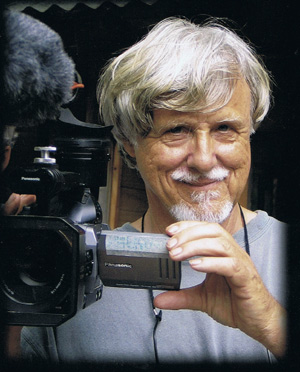
The more usual me. Life through a camera.

